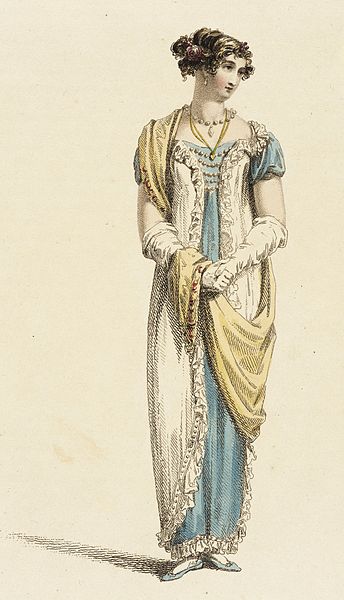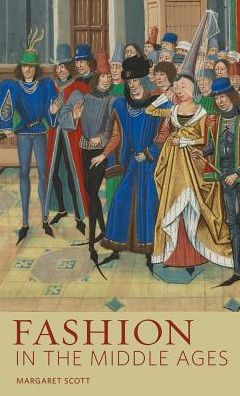Beyond the Muslin Gown

by Virginia Solomon, First published for the September/October 2011 issue of Finery

Too many times have I heard this statement, “I can’t wear Regency dress, I don’t have the body for it.” While it is true that many Regency illustrations depict willowy young things in clinging white gowns, there are many existing gowns in museum collections and illustrations, that depict gowns that are made in direct contrast to this image. They made with gorgeous fabrics such as Indian silks, wools, printed cottons and velvets in beautiful colors such as sapphire blue, deep greens, gold, and black – a veritable rainbow of colors. Embellishments of all types were used; tassels, froggings, ruches, beads, pearls, feathers, dyed gloves and shoes. Moreover, various styles of dress would include spencers, jackets, split gowns, half-dresses, full skirts, demi & formal trains, high necklines, v-necklines, and yes, long sleeves.
I fell in love with the Regency era dress by reading Jane Austen and Georgette Heyer novels. The following is a quotation from Heyer’s novel, The Grand Sophy. “This garment, when she appeared in it on the following afternoon, filled Cecilia with envy but slightly staggered her brother, who could not feel that a habit made of pale blue cloth, with epaulettes and frogs, a la Hussar, and sleeves braided halfway up the arm, would win approval from Miss Wraxton. Blue kid gloves and half-boots, a high-standing collar trimmed with lace, a muslin cravat, narrow lace ruffles at the wrists, and a tall-crowned hat, like a shako, with a peak over the eyes, and a plume of curled ostrich feathers completed this dashing toilette. The fitting habit set off Sophy’s magnificent figure to admiration; and from under the brim of her hat her brown locks curled quite charmingly …” This is the gown I wanted to make and wear, not the white clingy muslins worn by 16 year old ingénues.
Undergarments: if your gown is to fit appropriately, you must build a period structure to support it. Regency women would have begun with a plain chemise. This was usually made of linen or cotton, and its main purpose was to provide a barrier between the skin and stays. It was short, ending above the hem of the dress.
The next layer was a corset, or stays. There were two basic styles of Regency stays: short and long, lacing up the front. The short stays’ purpose was to support the breasts and smooth the upper torso, much like today’s modern bra. The longer stays provided a smooth line from chest to hip, supported the bust and promoted good posture. Cinching the waist was NOT the object of Regency stays.
The final layer before the gown was the petticoat(s). The purpose of a petticoat was to add fullness to the lady’s skirts and protect the fabric from clinging too closely to her curves. Due to the high waistline of Regency fashion, this had a fitted bodice with petticoats starting at …the empire waist. Petticoats were made of gathered light cotton, silk or wool depending on the time of year and the modesty of the wearer. The petticoats provided the correct Regency silhouette for women of any size, height or age.
Afternoon dresses were worn by every woman of society and fell into various forms such as walking, carriage or traveling dress and were generally worn to pay calls, visit the shops and attend exhibits. It is in the design of the afternoon dress that women could be in the best and most fashionable style, with beautiful trimmings, rich fabrics, and accessories. Afternoon dress accessories included gloves, muffs, and of course appropriate footwear. Other accessories included bonnets, fans, walking sticks and of course reticules. Depending on the time of year and weather, ladies also wore shawls, spencers, or the more elegant pelisse. A dashing hat or turban would be a wonderful way to complete your elegant and fashionable ensemble.
Keep in mind that during the day, the bust was entirely covered by the gown or a chemisette. Cleavage was for the evening, dinner or ball, so don’t make the mistake of showing your bosom during the day or you will risk the danger of being thought at best “fast” or at worse “without taste or manners.”
Another type of afternoon dress was the carriage or traveling dress. These were made out of slightly heavier fabrics, ones that would resist wrinkles better than cotton muslin. Also, they tended not to have as many trimmings, which could become crushed during a long carriage ride. These dresses would be very flattering for the fuller body, with its long elegant lines, simple trimmings and heavier richer fabrics.
Riding habits consisted of a dress with a very simple bodice and a jacket, which were generally ordered from a tailor and not your dressmaker. Ladies would wear a riding habit during rides in the park or the country. Made of sturdy cloth, riding habits were tailored with form-fitted jackets and wide long skirts to ensure comfort and modesty while riding. This ensemble was accessorized with a hat, gloves, boots and riding crop. Riding habits also took many details from masculine and military attire, often being decorated with military-style soutache, embroidery and epaulettes.
Half dress was more formal than afternoon dress, but not as formal as full dress. Ladies wore half dress in the late afternoon and into early evening. Half dresses had lower necklines and often came with demi-trains. They were perfect for the casual elegant look when one wanted to be seen and admired. Activities one would participate in while wearing half-dress might include going to an exhibit, afternoon card parties, promenading in Bath, visiting friends, early suppers and making formal calls.
Outerwear was an important part of dress; the hooded cloak (of velvet or wool) was always popular, as were many different styles of shawls. Shawls were often decorated with classical Greek motifs or with paisley patterns from India. The weights of shawls could vary from cashmere to light silk or even muslin in the spring and summer. Another type of outerwear was the spencer jacket, which was a high-waisted jacket worn over afternoon dresses.
A close relative of the spencer was the pelisse. Most pelisses were basically spencers with an attached skirt. Both spencers and pelisses took many details from men’s clothing, and often had a military theme. Because of the War with Napoleon, military details were extremely popular for most of the Regency. Pelisses were made of various fabrics (silk to wool) and often in rich colors and patterns. A perfect example is shown here of a beautiful emerald green pelisse, with froggings, ruffles and tassels.
For evening wear, to a ball, formal dinner, or an evening at Almacks, full formal dress was required. Unlike in afternoon dress, the bosom was prominently displayed, and often bejeweled with precious stones or pearls. The scoop neckline was most popular, however low square or wide scoop necklines were also worn. For evening wear, rich fabrics were worn such as Indian silks, satin, fine cambric, silk taffetas and silk velvet. These were often decorated with fine trimmings, metallic sequins, beads, fringe and embroidery. It was the general rule that the young debutantes wore white or the lighter pale colors with a simple string of pearls or beads. In formal wear the older woman was often able to outshine the youthful miss in their rich elegant attire.
While short sleeves were most often seen in evening dress, long (above the elbow) gloves were a necessity. Gloves, like stockings, were often in worn in many colors – often dyed to match the gown. The hair was often bedecked with plumes, jewels, bandeaus and turbans and hair curled to the fashion.
In closing, I would encourage all ladies, whether you are slim or built on generous lines, tall or short, old or young; to discount thoughts of “I have not the body for it” and design your new Regency gown with the knowledge that anyone could look wonderful on rich fabrics and colors with an elegant silhouette of a lady of the “haute ton” of Regency England.








John Sumpter
It is extremely accessible for me. Thank you for taking the time to discuss this. I feel strongly about it and love learning more on this topic.